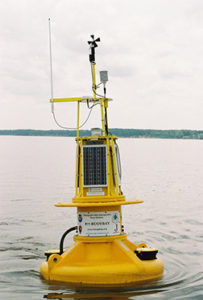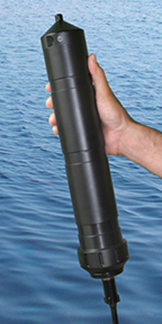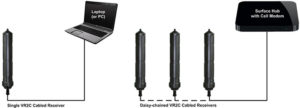VR2C : Cabled Receiver
-
Overview
The VR2C cabled receiver enables researchers to have a permanent, real-time communication path to the receiver allowing them to easily check on the status of the receiver in the field and upload data at any time.
The VR2C is designed to easily communicate to, or integrate with, the users top-side unit or surface hub. This might be a laptop computer, off the shelf data logger, instrumentation buoy, underwater glider, etc.
Applications
The VR2C cabled receiver is ideally suited for areas where cables are logistically possible such as instrumentation buoys, bridges, flood control structures, dams and fish passage systems.
Buoys of Opportunity
VR2Cs are being integrated into existing data collection systems.

Sample Configurations
Note: The Laptop (or PC) and the Surface Hub with Cell Modem are not provided by VEMCO.
For more details, see Downloads section.
Have you looked whether you need to update your VR2s? click here
-
Gallery

-
Frequently Asked Questions
What is the pin out configuration of the VR2C?
What voltage is required to power the VR2C externally?
Does increasing the external supply voltage increase detection range?
What is the power draw during serial communication?
How do I set up ASCII communication with my VR2C receiver?
Can I mate the VR2C connector underwater?
When and how should I change the battery?
When I connect to my receiver in VUE, I am prompted to update my firmware. What should I do?
What is the pin out configuration of the VR2C?
For pin out information, please refer to the VR2C Underwater Cable Guidelines document.
What voltage is required to power the VR2C externally?
The VR2C can run off external DC power between 10 and 30 volts. Please refer to the VR2C Underwater Cable Guidelines document for the DC +/- pins.
Does increasing the external supply voltage increase detection range?
No, the voltage level supplied to the VR2C does not impact receiver sensitivity. Detection range is really limited by the output power of the transmitters on the fish in addition to other environmental variables such as bathymetry, noise levels, absorption, thermocline and haloclines. For these reasons, we always recommend that customers perform range tests before and during a study to ensure they are detecting fish appropriately. For more information on range testing, please view our Range Testing Introduction and Range Testing Tutorial videos.
What is the power draw during serial communication?
This value is dependent on several factors including level of communication activity, RS232 or RS485, whether RS485 termination is enabled, baud rate and the hardware details of the serial port being used in conjunction with the VR2C. Assuming a high level of communication activity, power consumption will increase when transmitting data over the serial port. The exact level varies depending upon the configuration and activity. Users can expect the VR2C to typically draw between 3 and 12mA from a 12V external supply during serial communications.
How do I set up ASCII communication with my VR2C receiver?
For instructions on getting started with the ASCII interface, please see Section 3.2 of the VR2C User Manual (see Downloads section).
Can I mate the VR2C connector underwater?
The SubConn® connector (Micro Series MCBH8M) on the VR2C is “wet mateable” meaning it can be mated outdoors in potentially wet conditions. VEMCO does NOT recommend mating the connector while it is submerged underwater. Please visit the SubConn® website to learn more about connector specifications and connector maintenance.
When and how should I change the battery?
The VR2C receiver comes equipped with an internal D Cell 3.6 Volt lithium battery (Tadiran TL-5930/F) which will continue to power the receiver should the external DC power supply be interrupted. In the absence of externally supplied power, this battery will last approximately 10 months for the 69 kHz VR2C and 6 months for the 180 kHz VR2C. When external power is present, the battery will last 10 years or more before needing to be replaced. For instructions on changing a VR2C battery, please see Section 5.2.2 of the VR2C User Manual (see Downloads section).
When I connect to my receiver in VUE, I am prompted to update my firmware. What should I do?
For more information and instructions on updating your VR2C receiver’s firmware, please see the VR2C Firmware Update document.
-
Specifications
Specifications Dimensions 476 mm length, 88 mm diameter Weight 2.05 kg Maximum depth 500 metres Receiver frequency 69 kHz OR 180 kHz Data memory Approximately 1.6-million detections (16 Mbytes) Power supply Line voltage 10-32VDC, @12V record mode < 1ma, 3-15ma during communications, internal battery 3.6V D cell lithium Temp sensor Embedded temperature sensor in head (typical accuracy +/- 0.5C) Operating temperature -5°C to +40 °C (NOTE: Water in which VR2C is deployed must not freeze.) -
Downloads
